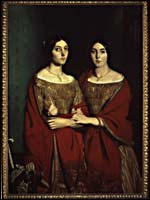
“There have been many artists greater than Chassériau,” acknowledge the curators of Théodore Chassériau: The Unknown Romantic at the Metropolitan Museum of Art, “but few who have produced a body of such consistently beautiful work.” Their distinction is an important one. Many painters who never develop a markedly original style still make significant pictures. And too often, modern scholars – intent upon the milestones of art history – treat these secondary artists with condescension. Poor Chassériau (1819–56) not only died at 37, before he could complete a full lifetime of work, but also was deeply influenced by both the “classical” Ingres and the “romantic” Delacroix. As a result, critics have traditionally faulted him for failing to resolve or transcend the different approaches to art represented by those two painters. To which the current show responds with an elegant Gallic shrug, as if to say, Why not enjoy?
Extraordinarily precocious, Chassériau became a student of Ingres’s at the age of 12 and painted several great portraits while still in his early twenties. In The Two Sisters, he presents his sisters as near-twins, each of whom nonetheless retains her own particularity. Their closeness conveys a subtle but profound intimacy, as if each found her reflection in the mirror of the other’s soul. Having made Ingres’s sinuous, elongated line his own, Chassériau went on to create many remarkable portraits and drawings largely in his master’s style. As a young man on the make, moreover, he vigorously competed for commissions – including religious ones – and took up the fashionable romantic enthusiasms of the day. He charged his forms with the heated color of Delacroix, turned his eye toward exotic scenes from the Orient, and painted a number of lush nudes. (As an adolescent, Philippe de Montebello, the director of the Met, slept with a reproduction of The Toilette of Esther under his pillow. The consequences are a source of ongoing speculation.) The artist’s most penetrating work remained in portraiture, however, where he brought warmth and a respect for human variety to Ingres’s sometimes chilly classicism. Americans should take a special interest in Chassériau’s painting of Alexis de Tocqueville (1805–59), the author of Democracy in America. Chassériau depicted Tocqueville as a betwixt-and-between man – at once aristocratic and democratic, introspective and observant, serious and wry. A man of exacting tensions, like America itself, like Chassériau himself.
Another secondary artist often treated with unfair condescension is Adolph Gottlieb (1903–74), the Abstract Expressionist who is now the subject of a small retrospective at the Jewish Museum. Like Chassériau, Gottlieb moved between two powerful spheres of influence, in his case geometric abstraction, which is sometimes regarded as a form of classicism, and biomorphic surrealism, which is sometimes viewed as a late efflorescence of romanticism. And like Chassériau, Gottlieb dreamed of a sublime art that could reach the deepest springs of human feeling. Gottlieb’s version of the exotic sublime was the Jungian landscape of the unconscious. In the forties, he began to make “pictographs,” paintings based upon a compartmentalized grid that contained loosely evocative forms and symbols.
“I’m involved primarily in polarities,” Gottlieb said. “The happy and the sad, the good and the evil, the sick and the well, pleasure and pain.” Throughout the fifties and sixties, he explored various ways of bringing such polarities together. One series was named “Unstill Lifes,” another “Imaginary Landscapes.” His best-known group, however, was the “Burst” paintings. Here, he would float a luminous orb of color above more turbulent forms or, sometimes, a series of geometric shapes. In one of his strongest works, Icon, a reddish sun glows above three vertical lines of orange, black, and yellow. The picture seems to embrace differences, promising an answer just beyond the edge of conventional meaning. Gottlieb would have agreed with Whitman’s famous declaration “Do I contradict myself? / Very well then I contradict myself, / (I am large, I contain multitudes).”
Art Listings
•Openings & Closings
•Museums
•Galleries
•Galleries
•Photography
•More
Théodore Chassériau: The Unknown Romantic
At the Metropolitan Museum of Art; through 1/5/03.
Adolph Gottlieb
At the Jewish Museum; through 3/2/03.